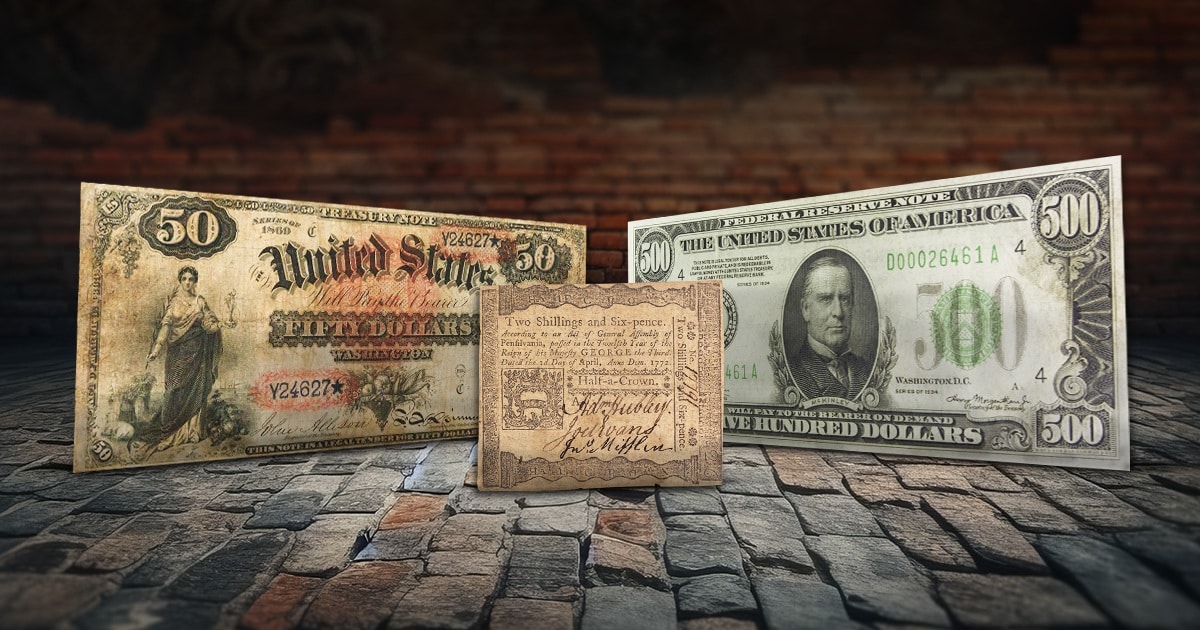
Even among numismatists, the currency is often overlooked as a collectible. However, currency may hold value, especially historical currency. Even Federal Reserve Notes from the 1960s are usually worth more than their face value.
Collecting currency is a rewarding hobby for many. Some even make a profit from buying and selling currency. A 1930s $100 Federal Reserve Note may be worth double its face value or Confederacy currency may be worth thousands of dollars.
So, not only is it an enjoyable endeavor, but it can also be profitable.
Types of Currency
There are many types of currency for you to choose from to collect. You can choose from U.S. and foreign currencies, foil notes, colonial pounds and shillings, gold and silver certificates, and obsolete bank notes.
Large Type U.S. Currency
Large-sized U.S currency was large at 7 3/8” by 3 1/8”, which is much larger than our current currency. In fact, they were so big, that they were nicknamed “horse blankets.” However large their size, carrying a few bills was easier than carrying gold or silver.
These bills were printed between 1861 and 1929. They were exquisitely designed. Large currency includes gold and silver certificates, legal tender notes, Federal Reserve notes, treasury or coin notes, national bank notes, and refunding certificates.
Examples of Large-Type Currency:
Buy Gold Certificates (Large Size) | APMEX
Small Type U.S. Currency
The “new” size of currency is 6 1/8” by 2 7/8.” The size was reduced to cut costs. The smaller notes required less paper, ink, and production expenses. They were also easier to carry around. The decision was made in 1927 and the new small type currency were distributed in 1929. National Bank Notes were also used from 1929 until 1935.
You still find older “dollars” in uncirculated state. Some make it a hobby to collect all the state National Bank Notes. Others collect star notes, which is currency that is printed to replace faulty bills. There are many ways to collect currency.
Examples of Small-Type Currency:
1929 $20 Brown Seal Federal Reserve Bank Notes
Global Currencies
Some collectors and investors enjoy collecting currency from around the world. Currency may be vintage or current years.
Africa
It is easy to collect currency from Zimbabwe. While it is not worth much, it can be fun to hold a billion-dollar bill.
Asia
Some collect historical money from the continent of Asia such as World War II currency.
Europe
Again, many like to collect WWII currency from Europe of modern Vatican banknotes.
North America
Many collect U.S. currency, but some also collect Mexican and Canadian currencies.
South America
Some collect money from South America including defunct dollars or pesos.
Other Types of Currency
It is popular to collect error money and obsolete notes. You can still find money printed before the US formed and some printed by the Confederacy.
Uncut Currency
Uncut currency is simply money in sheet form. These can be vintage or modern. They can e worth much more than face value.
Obsolete Notes
These types of notes are no longer useable. They may include local currencies disturbed by a local bank or refunding certificates. Obsolete notes are all vintage.
Error Currency
Error currency includes dollars with errors such as cutting, fold over, print, and over print errors. These can be worth much more than their face value. Some may be modern dollars.
Colonial
Colonial currency includes shilling and pound notes printed in the 1700s in colonial America in areas such as New Jersey, North Carolina, and Pennsylvania.
Confederacy
You can still find Confederacy currency. They were in circulation from 1861 to 1864. They were of little value because of the lack of gold and silver. But Civil War money can be worth quite a bit now.
How to Begin Collecting Currency
The first thing to do before you start collecting currency is to establish your budget and goals. Ask yourself, do I want to collect
- Currency as a hobby?
- To make a profit?
- To diversify my portfolio?
Answering this question can help you create your budget and will help guide you towards the type of currency you would like to collect.
Collecting Currency as a Hobby
If you want to collect as a hobby, you can start at any budget level. Perhaps, you simply want to collect every year of the $2 bill or Disney Dollars. Or maybe you would like to collect in relationship to a special interest of yours like obsolete bank notes. If you have a larger budget, you could collect large-sized gold certificates.
Collecting Currency for Profit
Collecting for a profit takes education, planning, and care and you still might not make a profit. Stick to your budgets and limit buying on a whim or for emotional reasons. You must also be patient and able to hold the currency to sell at the best time.
Collecting to Diversify a Portfolio
Any type of asset with value helps build your portfolio. You will want to select a currency that has proven to hold value over time. You may want to consider graded items to help you avoid buying counterfeit currencies.
Before buying, you will also want to ensure that you can properly care for the currency. For example, you may want to consider protective currency holders and a cool, dry, and dark place to store your safe. You may also want to consider adding them to your safety deposit box for extra protection.
Currency Education
Whether you plan to be a hobbyist or a large investor, you will need to educate yourself. Join forums, podcasts, associations, and social media groups. Attend coin shows that feature currency. Read and listen to books on the topic. Practice negotiating sales with lower priced items. Consult with reputable currency experts and dealers. And keep learning. The more you educate yourself, the better the experiences you will have.




